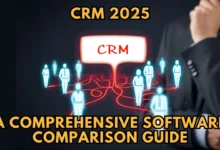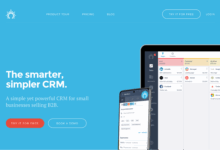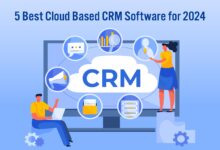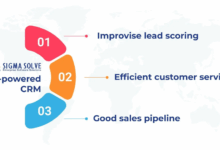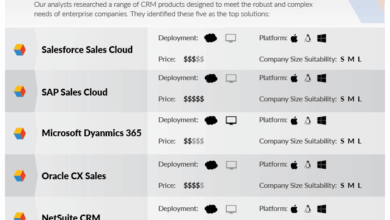CRM Software for Small Business Success
CRM Software for Small Business is more than just software; it’s a strategic investment that can significantly impact growth and efficiency. This guide explores the essential aspects of selecting, implementing, and maximizing the return on investment of a CRM system tailored to the unique needs of small businesses. We’ll delve into the various types of CRM solutions available, outlining their features and benefits while considering factors like budget and business type. This comprehensive overview will empower you to make informed decisions, ultimately leading to streamlined operations and improved customer relationships.
From defining your specific needs and choosing the right software to integrating it seamlessly with existing tools and training your team effectively, we’ll cover all the critical steps involved. We’ll also address potential challenges and offer practical strategies to overcome them, ensuring a smooth and successful CRM implementation journey. By the end, you’ll have a clear understanding of how to leverage CRM technology to drive your small business towards sustainable growth and enhanced customer satisfaction.
Defining Needs for Small Business CRM
A Customer Relationship Management (CRM) system is no longer a luxury for small businesses; it’s a necessity for efficient growth and sustained success. Choosing the right CRM involves understanding your specific needs and how a system can streamline your operations, improve customer interactions, and ultimately boost your bottom line. This section outlines the core functionalities of a small business CRM and explores how those needs vary across different business types.
Choosing the right CRM functionalities for your small business depends heavily on your industry and operational structure. A system that works perfectly for a retail store might be entirely unsuitable for a consulting firm. Understanding these differences is key to selecting the best fit.
Core Functionalities of a Small Business CRM
A successful small business CRM should offer a robust set of features to manage customer interactions and sales processes effectively. These core functionalities typically include contact management, sales pipeline management, reporting and analytics, and basic communication tools (email integration, possibly task management). Advanced features, such as marketing automation and customer service tools, are often desirable but not always essential, especially for smaller businesses starting out. The ideal CRM will integrate seamlessly with other business tools already in use, such as accounting software or email platforms.
CRM Needs Across Different Small Business Types
The specific CRM requirements differ significantly depending on the nature of the small business.
Retail businesses, for example, might prioritize features like inventory management integration, point-of-sale (POS) system integration, and customer loyalty programs. They need a system to track sales, manage customer preferences, and efficiently handle returns and exchanges. Detailed sales reporting is crucial for identifying best-selling items and understanding customer buying patterns.
Service-based businesses, such as hair salons or plumbers, might focus on scheduling and appointment management, customer history tracking, and service delivery optimization. The ability to manage appointments, track service history, and send automated reminders is vital. Reporting features should focus on appointment utilization, service revenue, and customer satisfaction.
Consulting firms, on the other hand, would likely prioritize project management features, client relationship tracking, and time tracking capabilities. They need a system to manage projects, track billable hours, and maintain detailed client records. Reporting should focus on project profitability, client lifetime value, and resource allocation.
Comparison of CRM Features Across Price Points
The following table compares three popular CRM features – contact management, sales pipeline management, and reporting – across different price points. Note that specific features and pricing vary greatly depending on the vendor and chosen plan. This table represents a general overview and should not be considered exhaustive.
| Feature | Free/Basic Plan | Mid-Range Plan | Premium Plan |
|---|---|---|---|
| Contact Management | Basic contact storage, limited tagging/segmentation | Advanced contact organization, custom fields, segmentation, integration with email marketing tools | Advanced contact management with automation, predictive analytics, and social media integration |
| Sales Pipeline Management | Basic pipeline visualization, limited deal tracking | Detailed deal tracking, customizable pipeline stages, sales forecasting tools | Advanced sales pipeline management with automation, sales process optimization, and predictive analytics |
| Reporting | Basic sales reports, limited customization | Customizable reports, dashboards, and key performance indicators (KPIs) | Advanced reporting and analytics with real-time dashboards, predictive modeling, and custom report creation |
Exploring CRM Software Options
Choosing the right CRM software is crucial for a small business’s success. The right system can streamline operations, improve customer relationships, and ultimately boost revenue. Understanding the different options available and how they fit your specific needs is the key to making an informed decision. This section explores various CRM software options, highlighting their strengths and weaknesses to aid your selection process.
Cloud-Based vs. On-Premise CRM Solutions
Cloud-based and on-premise CRM systems offer distinct advantages and disadvantages for small businesses. Cloud-based CRMs, hosted on a remote server, offer accessibility from anywhere with an internet connection, reduced upfront costs, automatic updates, and scalability. However, they rely on a stable internet connection and may involve monthly subscription fees. On-premise CRMs, installed directly on the company’s server, provide greater control over data security and customization, but require significant upfront investment in hardware and software, ongoing maintenance, and IT expertise. The choice depends heavily on the business’s technical capabilities, budget, and data security priorities. For many small businesses, the convenience and cost-effectiveness of cloud-based solutions outweigh the benefits of on-premise systems.
Popular CRM Software Options for Small Businesses
Several CRM software options cater specifically to the needs of small businesses. The following list highlights five popular choices, focusing on their key features and pricing models.
- HubSpot CRM: A free CRM with robust features including contact management, deal tracking, and email integration. It offers a freemium model, with paid plans providing advanced features like marketing automation and sales analytics. Pricing varies depending on the plan selected, starting with the free option and escalating based on added features and user numbers.
- Zoho CRM: A comprehensive CRM offering a wide array of features at competitive prices. It provides contact management, sales automation, marketing automation, and customer support tools. Zoho offers various pricing tiers, from basic plans suitable for solopreneurs to more extensive packages for growing businesses. The pricing is typically based on the number of users and features included.
- Salesforce Sales Cloud (Essentials): While Salesforce is known for its enterprise-level solutions, its Sales Cloud Essentials plan provides a simplified and affordable option for smaller businesses. It offers core CRM functionalities like contact management, opportunity tracking, and reporting. Pricing is subscription-based and varies depending on the number of users and required features.
- Freshsales: A user-friendly CRM known for its intuitive interface and robust sales automation capabilities. It includes features like contact management, deal tracking, and sales pipeline visualization. Freshsales also offers a tiered pricing structure based on the number of users and features.
- Agile CRM: A comprehensive and affordable CRM solution offering a wide range of features, including sales, marketing, and customer service tools. It offers various pricing plans to suit different business sizes and needs, often including a free plan with limited functionality.
Examples of Successful CRM Implementations
A bakery chain using HubSpot CRM to manage customer preferences and loyalty programs, leading to increased repeat business and improved customer retention. A small law firm using Zoho CRM to track cases, manage client communication, and improve overall efficiency, resulting in reduced administrative overhead and increased billable hours. A boutique clothing store leveraging Salesforce Essentials to manage customer relationships, personalize marketing campaigns, and analyze sales data, leading to better inventory management and targeted promotions. These examples showcase how different industries can benefit from CRM software implementation, regardless of size.
Implementing and Using CRM Software
Successfully implementing a CRM system requires careful planning and execution. The process involves more than simply installing the software; it demands a strategic approach to ensure seamless integration into your existing workflows and a smooth transition for your employees. This section outlines the key steps to effectively implement and utilize your chosen CRM for optimal business benefit.
CRM System Setup and Configuration
Setting up your CRM involves several crucial steps. First, you’ll need to import existing customer data, ensuring accuracy and consistency. This might involve cleaning up your existing data to remove duplicates or inconsistencies before importing. Next, customize the system to reflect your specific business processes. This includes defining fields, creating workflows, and establishing reporting parameters. Finally, thoroughly test the system to identify and resolve any potential issues before full deployment. A phased rollout, starting with a small group of users, can help identify and address any unexpected challenges early on. For example, you might begin by importing only a portion of your customer data and testing the core functionalities before expanding to a larger dataset.
Integrating CRM with Other Business Tools
Effective CRM implementation often necessitates integration with other crucial business tools. Seamless integration with email marketing platforms allows for targeted campaigns and automated follow-ups. Connecting your CRM to accounting software streamlines invoicing, payment processing, and financial reporting. For instance, integrating with Mailchimp allows for automated email sequences triggered by customer actions within the CRM. Similarly, integration with Xero or QuickBooks allows for automated invoice generation based on sales activities recorded in the CRM. This reduces manual data entry and minimizes the risk of errors. Consider the specific needs of your business when selecting integration options, prioritizing those that offer the most significant efficiency gains.
Employee Training on CRM System Usage
Comprehensive employee training is vital for successful CRM adoption. A well-structured training program should cover all aspects of the system, from basic navigation to advanced functionalities. This might involve a combination of online tutorials, hands-on workshops, and ongoing support. Regular check-ins and feedback sessions ensure employees feel comfortable using the system and can address any questions or challenges they may encounter. For example, create a short training video demonstrating core functionalities, followed by a hands-on session where employees can practice using the system with sample data. Consider assigning a CRM champion within the team to provide ongoing support and answer questions. Providing clear documentation and readily available support resources is also critical for long-term success.
Measuring CRM Effectiveness
Implementing a CRM system is only half the battle; understanding its impact on your small business is crucial. Measuring the effectiveness of your CRM allows you to justify its cost, identify areas for improvement, and ultimately, maximize its return on investment. This involves tracking key metrics and analyzing data to understand how your CRM is contributing to your business goals.
Effective CRM measurement requires a strategic approach, focusing on relevant metrics and consistent data analysis. By tracking the right data points, small businesses can gain valuable insights into sales performance, customer engagement, and marketing campaign success. This data-driven approach enables informed decision-making, leading to optimized CRM utilization and improved business outcomes.
Key Performance Indicators (KPIs) for Small Business CRM
Several key performance indicators (KPIs) can effectively gauge the success of your CRM system. These metrics provide a quantifiable measure of your CRM’s contribution to overall business performance.
- Sales Growth: Track the increase in sales revenue attributed to improved lead management and sales processes facilitated by the CRM. Compare sales figures before and after CRM implementation to assess its impact.
- Lead Conversion Rate: Monitor the percentage of leads that convert into paying customers. A higher conversion rate indicates improved lead qualification and nurturing processes within the CRM.
- Customer Acquisition Cost (CAC): Analyze the cost of acquiring a new customer, comparing it to pre-CRM figures. A lower CAC suggests that the CRM is optimizing your marketing and sales efforts.
- Customer Lifetime Value (CLTV): Measure the total revenue generated by a customer throughout their relationship with your business. A higher CLTV indicates successful customer retention strategies supported by the CRM.
- Customer Satisfaction (CSAT): Regularly assess customer satisfaction through surveys and feedback mechanisms. High CSAT scores reflect improved customer service and engagement facilitated by the CRM.
- Sales Cycle Length: Track the time it takes to close a sale. A shorter sales cycle indicates improved efficiency in the sales process, facilitated by the CRM’s streamlined workflows.
Creating Reports to Analyze CRM Data
Regular reporting is essential to understand your CRM’s performance. Reports should focus on key metrics and provide actionable insights. These reports can be generated directly from your CRM software or through external analytics tools.
| Metric | Period | Value | Trend |
|---|---|---|---|
| Lead Conversion Rate | July 2023 | 15% | Up 5% from June |
| Average Deal Size | July 2023 | $500 | Up 10% from June |
| Customer Satisfaction (CSAT) | July 2023 | 4.5/5 | Stable |
| Sales Cycle Length | July 2023 | 14 days | Down 3 days from June |
Visualizing the Relationship Between CRM Usage and Business Outcomes
A simple chart can effectively illustrate the connection between CRM usage and key business outcomes. For example, a line graph could display the increase in sales revenue (y-axis) alongside the increasing adoption rate of the CRM system (x-axis) over a period of time. This visual representation would clearly demonstrate the positive correlation between improved CRM usage and higher sales figures. Another chart could show customer satisfaction scores improving in tandem with increased use of CRM features for customer support and engagement. This visual representation would showcase how effective CRM utilization translates into improved customer relationships and loyalty.
Addressing Challenges and Limitations
Implementing a CRM system, even a seemingly simple one, can present several hurdles for small businesses. These challenges often stem from a combination of internal factors, such as resistance to adopting new technologies, and external factors, like the limitations inherent in certain software options. Successfully navigating these obstacles is crucial for maximizing the return on investment in a CRM system.
Successfully integrating a CRM system requires careful consideration of potential problems and proactive strategies to mitigate them. Overcoming these challenges is vital for ensuring the CRM system becomes a valuable asset, rather than an unused piece of software. This section will explore common challenges, effective mitigation strategies, and the trade-offs associated with different CRM pricing models.
Resistance to Change and Lack of Training
Implementing a new CRM often meets resistance from employees accustomed to existing workflows. This resistance can manifest as reluctance to learn new software, concerns about job security, or simply a lack of understanding of the CRM’s benefits. Effective training is paramount. This involves not only technical training on how to use the software but also demonstrating its value proposition to individual employees and the business as a whole. For example, showing how the CRM can streamline their daily tasks, reduce administrative burden, and improve customer relationships will significantly increase buy-in. Furthermore, providing ongoing support and readily accessible resources ensures continued engagement and proficiency. A phased rollout, starting with a pilot group, can also minimize disruption and allow for iterative improvements to the training process.
Limitations of Free or Low-Cost CRM Options
Free or low-cost CRM options often come with limitations that can hinder a small business’s growth. These limitations frequently include restricted features, limited storage capacity, fewer integrations with other essential business tools, and inadequate customer support. For instance, a free CRM might only allow a small number of user accounts, preventing the entire team from utilizing its capabilities. Similarly, limited integration capabilities could prevent seamless data flow between the CRM and other crucial systems like accounting software or email marketing platforms. While these options can be suitable for very small businesses with minimal needs, they often become insufficient as the business scales. Investing in a more robust, paid CRM solution becomes increasingly beneficial when the business requires advanced features, such as robust reporting and analytics, customized workflows, and dedicated customer support, to effectively manage growing customer bases and complex sales processes. The cost of a premium CRM should be weighed against the potential increase in efficiency, revenue generation, and improved customer satisfaction it offers.
Data Migration and Integration Challenges
Transferring existing customer data from disparate sources into a new CRM system can be a complex and time-consuming process. Inaccurate or incomplete data can lead to flawed analysis and poor decision-making. Careful planning and potentially professional assistance are often necessary to ensure a smooth and accurate data migration. The process requires data cleansing, validation, and mapping to ensure compatibility with the new CRM system. Furthermore, integrating the CRM with other business systems, such as email marketing platforms, accounting software, and e-commerce platforms, is crucial for maximizing efficiency. This integration can require custom development or the use of third-party integration tools, which may add to the overall cost and complexity of the implementation. Careful consideration of data security and privacy regulations throughout this process is essential.
Closing Notes
Implementing the right CRM software can be transformative for a small business. By carefully assessing your needs, exploring various options, and diligently following implementation best practices, you can unlock significant benefits. Remember that ongoing monitoring and adaptation are key to maximizing the value of your CRM investment. From improved customer relationships and streamlined sales processes to data-driven decision-making, a well-integrated CRM system empowers small businesses to compete effectively and achieve sustainable growth. Don’t just manage your customers; cultivate lasting relationships that fuel your success.
